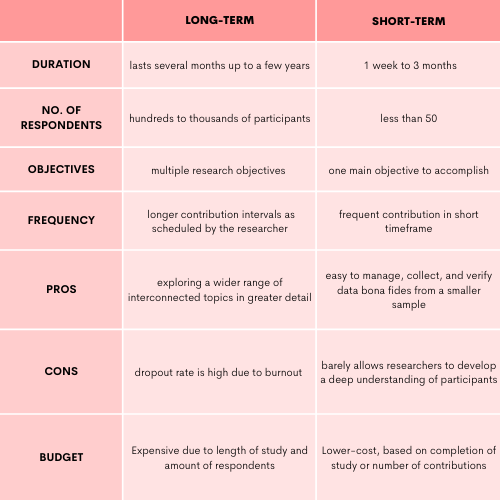Gone are the days when researchers had to gather consumer feedback manually. With the help of market research online communities or MROCs, you can now automatically collect market insights through spontaneous contributions.
MROC market research consists of people recruited into a private online space to participate in research-related activities over a certain period. This method gives you the flexibility to custom design your study according to research objectives, but there are mainly two types of online communities – long-term and short-term.
Now, how would you know which type is the best for you? In this article, we give a thorough breakdown of these two MROCs so you can select the most suitable format for your market research.
Long-Term
Long-term or continuous market research online communities are composed of hundreds to thousands of participants involved in lengthy projects that usually last up to a few years. Respondents' insights about interlinked topics and situations are harvested from an online community platform or bulletin board.
Using a fixed group of participants throughout the study is highly recommended in long-term MROCs to decipher how opinions change under different circumstances – allowing you to conduct situational experiments for behavioral observation and data mining.
A large number of participants generate a wealth of insights for you to manage and choose the most valuable information to incorporate in your report. This format has the advantage of exploring a more comprehensive range of topics in greater detail, as continuous feedback is an invaluable asset for any business. Thus, enabling researchers to understand participant sentiment in-depth and align their decisions accordingly.
Participants are not obliged to return to the community platform or online bulletin board to contribute insights as frequently as short-term MROCs do. Longitudinal communities require participants to submit feedback when scheduled by the researcher to avoid ineffectual insights cluttering the platform.
Downsides and Solutions
The dropout rate is high in these lengthy online communities. Keeping participants engaged and motivated to participate in a year-long study (or more) is difficult, as many discontinue their involvement because of a lack of time or interest.
Low interest rates and poor outputs also result from involving people with irrelevant backgrounds. Recruiting the right people for market research is a crucial process, yet it’s still often overlooked.
One way of maintaining or boosting engagement in long-term MROC market research is through gamification. Users could engage in various activity options that can be customized as necessary to the study, such as open-ended text responses, mark-ups, sort and rank, pooling grids, and media file uploads.
It is important to screen and recruit the most qualified participants to collect superior data and steer clear of uninterested individuals dropping out in the middle of the study. Offering a variety of worthwhile incentives also keeps the engagement going until the end of the study.
Short-Term
Short-term or ad hoc market research online communities are comprised of a limited number of members (up to 50). Participants are grouped by common interests to regularly brainstorm, assess, and hone ideas around a given research topic on a short-run online research platform. This MROC type only has one main objective to accomplish, which makes its duration shorter – usually not exceeding more than four months.
Due to their short time frame, these MROCs tend to be intensive as researchers are more pressured to fulfill project requirements on time. This requires participants to frequently return to the digital community platform or online bulletin board to spontaneously contribute insights.
Short-term online community participants are fixed from start to finish. They do not recruit, change, or replace participants in the process, as each study should be completed before recruiting a new set of respondents for another project. This prevents the disruption of the group’s dynamics and possible compromises in data value.
Downsides and Solutions
The small participant volume of ad hoc communities makes it easy to manage, collect, and verify data bona fides. However, a limitation of a shorter time frame is that it barely allows researchers to develop a deep understanding of participants’ characteristics, experiences, and beliefs.
Deciding to go with short-term research communities isn’t mainly dependent on whether or not you want to gather agile information. Several factors need to be taken into consideration, such as research objectives.
As mentioned, short-term is only ideal for those who only want to focus on one main objective. Multiple objectives require a longer completion time which is difficult to compress and conduct in a short amount of time. In these cases, long-term market research online communities are recommended.
Short-term market research online communities are typically less expensive than long-term due to the smaller sample of participants, but requiring them to contribute frequently can also be costly. A great example of this is “Cash for Comments.” This means the more insights participants contribute, the more rewards they may feel entitled to.
Being obliged to contribute every day can push participants to be less engaged. Insight sharing shouldn’t be seen as a strenuous task. To prevent members from dropping out, carefully strategize how to quickly generate enough feedback. This could be done by creating a balance between authentic responses and the frequency of submissions. Gamification of activities, rewards, and objectives could also motivate participants to actively comply and participate.
What’s The Best MROC for You?
In choosing which type of market research online community will best fit your needs, there are three things that you must take into consideration.
1. Budget
How much are you willing to allocate for data collection? This correlates directly with how long you would conduct research and the number of online community members you would like to recruit. Typically, the longer a study is, the longer you have to pay your respondents. Also, the larger your online community is, the more people you would have to disburse.
2. Time
The format of your online community is determined by how long you think it will take to accomplish your research objectives and how fast you need results. Short-term communities are good for generating agile results from one research objective. At the same time, long-term is more suitable for gathering in-depth insights on various topics and objectives.
3. Quality
One of the main differences between long-term and short-term is the quality of data you collect. While both market research methods could produce valuable insights, the extended timeframe and larger sample size of long-term communities tend to provide more in-depth data than short-term.
Gather Robust Insights from Your Online Communities with Civicom Chatterbox™
Civicom ChatterBox™ has powerful yet user-friendly capabilities to help you engage respondents better. Choose activity options like questions, exercises, and problems, to gain honest and actionable insights from your respondents. Manage your bulletin board projects and get the authentic feedback you need. Know how you can utilize ChatterBox for your research.
{{cta('0eb81ed9-3a40-41b2-adb0-1b8b7e1aa5a9')}}




